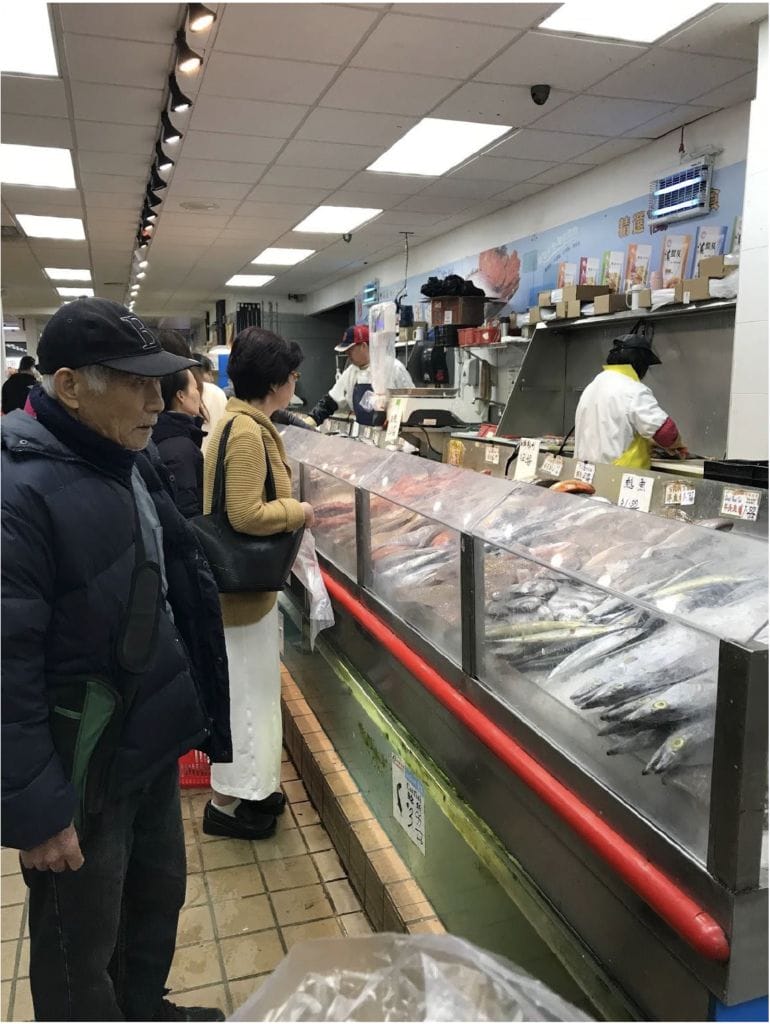
“Seafood Encounters” by Robert. All photos © 2020 by Inside Chinatown participants.
Beauty is around you. You have to discover it and use your heart to feel it.
—Inside Chinatown Participant
“Seafood Encounters” is a photo of the fish counter at a local grocery store with a male Chinese worker in the background filleting a fish. The caption reads, “They have surgeon-like precision when filleting the seafood. In fact, some of them were surgeons before they immigrated here.” This image and others in Robert’s series of photos entitled Unsung Heroes and Heroines are a testament to the day-to-day struggles and sacrifices of immigrants like his parents and workers in Chinatown.
Robert is a worker in Boston Chinatown who participated in the Inside Chinatown project to document the neighborhood, which is critical during this time of rapid displacement of residents, luxury development, and gentrification. As an immigrant who came from China at an early age, Robert spent his childhood accompanying his father to the restaurant where he worked. Robert was struck by his father’s story and his sacrifices—a man who had a good job in China but immigrated to the United States because he felt his family could have a better life here. Restaurants are fundamental to the ecosystem and economic viability of Chinatowns across the U.S. and their immigrant workers, yet we do not often know about the lives of the workers (Lee 2013). In illuminating the significance of restaurants and restaurant workers, Robert wanted to shed light on the people “who do not get enough credit.” He hoped his photos encourage people to have a broader perspective on workers in Chinatown aside from their role as workers. About the restaurant workers and dishwashers, “There is so much more to them,” Robert asserted.
For residents and workers like Robert, Boston Chinatown is one such Chinatown that is fighting to maintain its historical and cultural legacy as a home to the Chinese immigrant community in the wake of rapid displacement of longtime residents and luxury development (Lee and Bell 2019). These development trends affect not only residential composition but also the health and well-being of remaining residents, particularly the elderly and recent immigrants, who experience more stress and social isolation. The majority of Asian households in Chinatown have limited English proficiency and rely on both formal and informal social networks of neighborhood service providers, nonprofits, friends, and relatives to access jobs, services, and translation assistance.
This article presents a case study of Inside Chinatown, a project that enabled current and former residents and workers of Boston Chinatown to use photography and visual storytelling to create their own narratives about this moment in Chinatown’s history. The project took place November 2018 to December 2019. First we describe the structure and curriculum of the project, followed by examples of participants’ photos. The participants in the program, workers and residents in Boston Chinatown, documented their daily experiences, engaging with Chinatown’s history, notions of home, traditions, rituals, and identity to address the question asked by the program for participants to consider: “What does Chinatown mean today and how does it shape a Chinese American identity?” They took photos, wrote artist statements about the work, and wrote captions to accompany the photos. The artist statements provided context for the series of photos taken by each artist and their intentions of what they were trying to capture through the photographs. This year long project culminated in a group photo exhibition at Pao Arts Center. Their photos are multifaceted stories of the people of Chinatown, whose stories collectively, as Robert wrote, “may be longer than the Great Wall of China!”
Informal learning spaces: Creating conditions for community-based education
Inside Chinatown took place at Pao Arts Center (the Center) in Boston Chinatown. The Center opened in January 2017 as a new arts space. It is a project of the Boston Chinatown Neighborhood Center (BCNC), the largest social service agency serving the Asian community in the Greater Boston region, and Bunker Hill Community College. BCNC’s vision for the Center was to amplify Asian American and Asian immigrant voices and create a physical community space for using art, culture, and creativity to improve health and well-being of the neighborhood.
Center staff and University of Massachusetts Boston (UMB) faculty conceived of this project, which was supported by Mass Humanities. BCNC and UMB Asian American Studies have a longstanding relationship. The project team included members from the institutional partners. The Project Scholar (Loan Dao) and Project Facilitator (Izabela Villaneuva) were from UMB and specialized in Asian American and Ethnic Studies. The Project Director (Cynthia Woo) and Project Associate (Vanessa Woo) worked at the Center.
The team designed the participant application to be bilingual in English and Chinese, and applicants could complete it by phone, email, or hand. The project team had a mix of native Cantonese, Mandarin, and English speakers. The Project Associate provided simultaneous translation for two participating elders who spoke Cantonese. Outreach through the Chinese Residents Association, senior classes at the Center, neighborhood business owners, and UMB residential buildings produced a mix of participants, including residents, business owners, high school students, retirees, and administrative workers. The age range was equally diverse with two high school students, four seniors, and participants of many ages in between.
The pedagogical approach of Inside Chinatown demonstrated best practices in how to bring local cultural knowledge to bear on important social justice issues using the power of observation through visual storytelling. Spiegel (2020) argues that when historically marginalized communities have the power of telling their own stories through visual storytelling in photography, “ideas about ‘place’ and the relations that shape particular place-based knowledge could be framed through diverse individual and collectively shared histories, inflected by class, gender, age, ethnicity, and a range of idiosyncratic experiences that might defy such categories” (126). Visual storytelling attempts to re-center historically marginalized communities to narrate their own stories, highlighting narratives that are important to them, thus reframing themselves through counter-hegemonic stories and creative practice. This methodology involves teaching people how to use cameras and preparing them to tell stories through a process of prompt-based, scaffolded discussions that illicit their stories as experts of their own lives, removed from dominant cultural perceptions of them, their culture, and their environment (Wang and Burris 1997). Making the program accessible, in terms of schedule, language, and income, facilitated participation of some people who often do not have access to formal learning spaces. The iterative curricular design gave space for participants’ voices, experiences, and perspectives to drive the evolution of the program organically, ensuring that it always was rooted in community knowledge. The Curriculum Example in our Classroom Connections at the end of this article illustrates how the curriculum evolved over time to embody these principles.
In recognition of financial barriers to participation, the residents and workers received a stipend. In addition, three cameras were available for participants to check out and use for the January-June 2019 photography process. Editing equipment such as a laptop with editing software was available at the Center during open hours, 9:00 am-8:00 pm, Monday-Saturday. The elders would often use the equipment during weekdays. The Project Facilitator remembers that one participant watched YouTube videos to learn to use all the camera functions and started taking photos from the beginning. This student, Edward, said, “I wanted to have as much practice as possible to create the best final pieces.”
All four project team members collaborated in the curriculum planning phase and development of the overall framework. They ensured that the academic content was balanced with interactive, discussion-based activities so sessions were not didactic. Brief evaluations followed each session. The team met regularly to debrief sessions, look at evaluations, create a preliminary structure for each upcoming workshop, and talk through how to make the content streamlined and accessible. During workshops, the team quickly realized they had to make real-time decisions and adjustments to make sure the workshops were accessible and relevant to participants.
Using photography and storytelling to create resident and worker-centered narratives
This program was inspired by photographer Katie Salisbury’s photo essay Thank You, Enjoy, a portrait of restaurant and food delivery workers in New York City’s Chinatown. The Project Scholar initially explored ways to connect issues of race and ethnicity with worker rights. On a visit to New York, she happened upon Salisbury’s exhibit. Her work extended beyond the specific geography of the city’s working class of Chinatown to the experiences of Chinatown workers across the country. The Project Scholar reached out to Salisbury, the UMass Boston Labor Resource Center, and Boston Chinatown organizations to explore whether a collaboration to bring the exhibit to New England was of interest to these campus and community partners. The Center Director suggested a broader program that integrated local Chinatown workers and residents and highlighted Boston Chinatown. Together, the Project Director and Project Scholar created Inside Chinatown, for which the Center received a grant to pay for participant stipends, a bilingual-bicultural graduate student assistant to facilitate the program, photography equipment, and Center staff time. Thank You, Enjoy opened at UMass Boston in November 2018, as a collaboration with UMass Boston’s Labor Resource Center and Asian Student Center. It featured a public opening reception and panel with the artist, exhibition partners, and guest speakers from the Chinese Progressive Association, and served to recruit participants for the Inside Chinatown project. Salisbury’s work gave a real live example of what a photography exhibit generated by the actual workers and residents of a neighborhood could look like. Engagement with Salisbury was interwoven through the curriculum. She worked with the cohort at the beginning of the program and toward the end. In session one Salisbury modeled her storytelling process for Thank You, Enjoy from image selection, photography technique, written artist statements, and caption, and in session two she worked one-on-one with participants to deliver feedback and refine their own stories and photographs. Her exhibit grounded the work of the project team and allowed participants to see a model of how photography could shed light on untold stories, preparing participants to create narratives rooted in their experiences, rituals, and traditions.
At the onset, the project team was deliberate in setting up the project to be an ongoing community resource. Photographs and artist statements would be archived at the Chinese Historical Society of New England (CHSNE), a local nonprofit dedicated to preserving Chinese American history for present and future generations. Archiving the photographs ensures residents’ and workers’ perspectives are given priority when remembering this time in Chinatown’s history. Housing the photographs at CHSNE ensures that this community resource can be accessible to others and be used as archival materials for classroom use, representing a perspective not typically heard in formal academic spaces.
The Chinatown Gate: The power of intergenerational storytelling
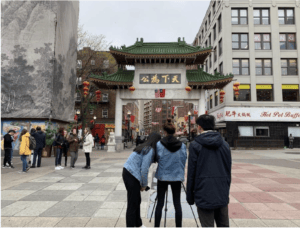
“Popular Gate” by Yang.
Visual storytelling enabled participants to use close observation to capture contemporary moments in the life of Boston Chinatown that represented history, resilience, identity, and beauty. In the Asian American Studies context, community-based education focuses on priorities of the community and highlights voices often marginalized in academia, namely immigrants, non-English speakers, workers, and low-income populations (Omatsu 1994, Hirabayashi 1995, Osajima 1998, Le and Sy 2019). In Inside Chinatown, the gaze of the workers and residents brought to light important cultural symbols of the community. For example, the Boston Chinatown Gate was a common image captured by both youth and elders as a symbol for belonging. Three participants featured the Chinatown Gate prominently in the center of their photos, clearly illuminating the importance of this landmark through their composition. One elder, Eugene, wrote, “The gateway of Chinatown has shed light on a pathway to Chinatown where we can conduct our lives almost as if we were still in our homeland.” As an immigrant and longtime Chinatown resident, Richard saw it as an important reminder of his immigrant past in China and his childhood. Eugene saw it as a symbol of “civility, justice, integrity, humility.” Eugene and Richard captured the Gate at a moment of quiet, with few other humans figured in the composition. In contrast, Yang, a high school student, saw the Gate as a tourist icon in “Popular Gate.” His image is filled with human movement, capturing the Gate at a moment when a group of students captured the site themselves.
This common theme of the Chinatown Gate illustrated how the intergenerational design of the program manifested itself visually and organically. The Project Facilitator intentionally framed workshops to elicit traditions, rituals, and memories. The iterative nature of the program allowed the stories to shape the process as the workshops unfolded. For example, the project team paired intergenerational individuals for group discussion and exchanging ideas. After one senior, Richard, saw another participant’s presentation of photos, he told him that his project really resonated with him. The two men began talking to each other about their stories and noticing similarities in their experiences. Sometimes participants brought in other photos or artifacts to share with the group to talk about their immigration story, providing context and detail for how Chinatown has evolved over time. By the last session, conversation had moved beyond talking about the photos. Seniors advised teen members on how to apply for college scholarships. Teens, in turn, showed seniors how to edit pictures on phones.
“Still Standing”: Chinatown narratives of resilience

“Still Standing” by Edward.
Workers’ and residents’ perspectives on Chinatown captured through photos showed a community resisting the forces of gentrification that threaten to change the human and physical landscape of the neighborhood (Main and Bell 2019). Visual storytelling serves as an important way to claim and reclaim voice and space. Storytelling is a powerful tool to convey perspectives and values (Fairbairn 2005). Between 2000 and 2018, the number of high-end and luxury housing increased from 561 units to 2,602 units (Chinatown Master Plan 2020). At the time of this writing, there were three proposals for new hotels in the neighborhood. Despite this development, Chinatown remains a “Community of Contrasts” (Asian Americans Advancing Justice 2011). It is one of the densest and poorest neighborhoods in Boston. Chinatown has the lowest median income but the highest median rent (Chinatown Master Plan 2020). Median income is $17,997 compared to the citywide average of $62,021 and the adjacent neighborhood of Downtown at $113,678. More than half the residents live in households whose income is considered “extremely low” under U.S. Housing and Urban Development’s definitions, meaning at or below 30 percent of the Boston area median. Displacement threatens the sense of community and tight knit social fabric.
Despite these threats to the character, social fabric, and future of the neighborhood, Inside Chinatown photographs capture the strength and resiliency of the community. Edward wrote that his photo “Still Standing” is an old Chinatown building that “displays a faded advertisement for a long-closed restaurant in Chinatown.” The building sits squarely in the center of the photo “flanked by two expensive downtown high-rises,” which could be read as simply the changing landscape of Boston. Edward, however, wrote how this “juxtaposition of the newer skyscrapers in the background and the weathered building in the forefront symbolizes the resiliency of Chinatown even with the encroachment of neighboring development.”
“I Am 竹昇” (Jook Sing): Forging a unique Chinese American identity
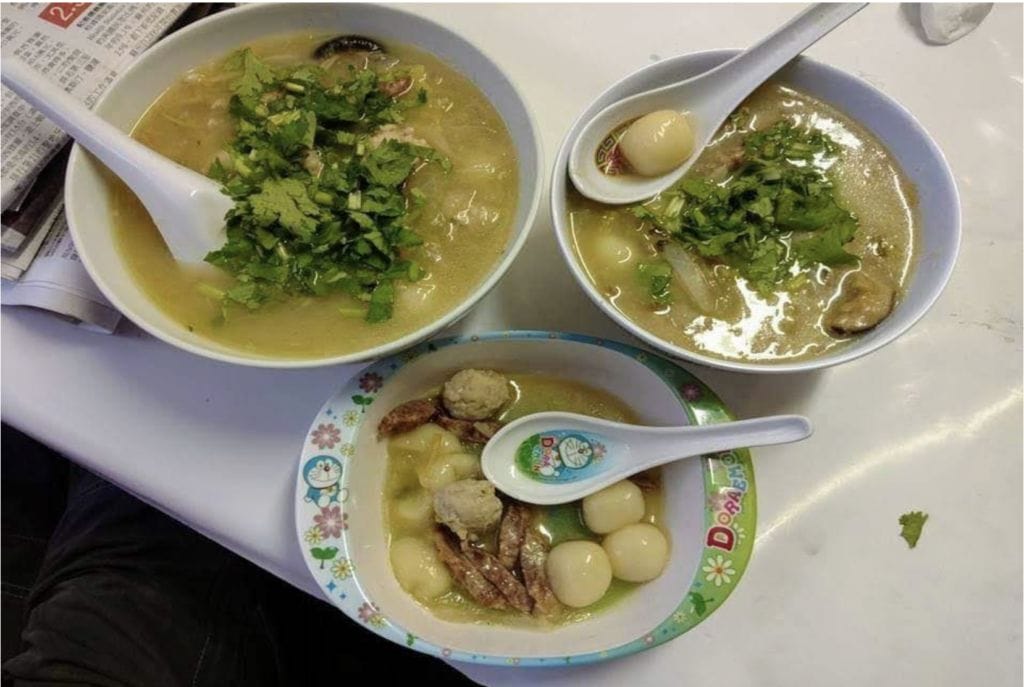
“湯圓 (Tang Yuen)” by Liz.
The Project Director and Project Facilitator incorporated hands-on group work and discussion around cultural traditions, personal narratives, and experiences of Chinatown, with a focus on intergenerational conversations and pairings. Residents and workers used photography to observe rituals and practices in their personal lives. In doing so, their photographs demonstrated what Chinatown means to them and their families and what is at stake in maintaining their heritage. In her series of photos entitled Traditions of a Jook Sing, Liz reflected on occupying two cultural spaces: growing up in the U.S. eating meatloaf and mashed potatoes one day and Chinese sausage the next. She describes her choice of the theme Jook Sing:
The term Jook Sing is Chinese slang used in a negative way to refer to Chinese who were not born in China. It translates to hollow bamboo; the bamboo is hollow and compartmentalized, and thus water poured in one end does not flow out of the other end. The metaphor is that Jook Sings are not part of either culture—water within the Jook Sing does not flow and connect to either end. [My mother] taught us to embrace the term positively, and she showed us that we get the best of both worlds. We weren’t just Chinese and we weren’t just American; we were Chinese American and with that we got to break the mold of stereotypes and create our own identity.
Most of her photos depict traditional Chinese rituals, traditions, and food made for Chinese holidays such as Lunar New Year, Winter Solstice (“Tang Yuen”), Grave Sweeping Day, Mid-Autumn Festival, and Ching Ming, or Chinese Memorial Holiday, when families go to the cemetery to pay respect to the ancestors by lighting incense, bringing food, burning money, and bowing with respect three times.
When Liz exhibited her photos at the Center, she placed two contrasting photos deliberately side by side. A picture of her daughter’s baptism, family gathered around a baptismal font, stood in contrast to the picture of the same child having a red egg rolled over her head, a traditional Chinese custom for newborns. These pictures illustrate the blend of western and Chinese traditions. Although Liz admits that knowledge of the origins of these traditions may have been lost, the meaning of the tradition and the connection to heritage are still salient and resonant with the Jook Sing. Although the legacy of racism and colonialism has caused many immigrants to become disconnected from their heritage, Liz, through her visuals, reclaims the beauty and richness of being part of two cultures, determined that her Chinese heritage not be replaced by the commercialization and commodification of Asian “otherness” (Lee 1999). Liz’s approach to her exhibit, her curatorial choices, and her photographic content offer an insight into the ways in which the participants used this program as an opportunity to disavow the spectacle of Chinese cultural exoticization to share cultural rituals and traditions that carry meaning and memory within the Chinatown community (Anderson 1987, Andreoli 1994).
Digital storytelling challenges stereotypes and creates counternarratives as it humanizes (Greene et al. 2018.) During the process of creation, individuals have the opportunity to “learn about self through story-making” and “establish a sense of community by learning history” (Greene et al. 2018). Engaging in visual storytelling provides a sense of safety so that individuals can “express vulnerability.”
“Raining and Wet”: Shining light on the beauty of everyday life in Chinatown

“Raining and Wet” by Ling.
Using photographs of everyday life, participants captured subtle moments of life in Chinatown that show the neighborhood’s elegant beauty and counter stereotypes of Chinatown as “dirty.” Through photographs, individuals can “indirectly speak about thoughts and feelings” (Prasetyo 2017). It is a particularly powerful tool for marginalized groups who are often seen as “the other” (Greene et al. 2018). To tell the story of Chinatown from an insider’s perspective, the residents and workers used a creative process. They learned to use the camera, tell their narrative through photographs, use photography to capture what particular perspectives looked like and what order photos should be in. See our Classroom Connection worksheets, Photography 101 and Visual Analysis for examples of the tools developed for participants. The sessions used a variety of media to explore history, including archival photos, lectures, walking tours, and contemporary photography. This process allowed participants to engage in visual analysis; critical thinking; and photo composition, technique, and curation. Participants used these tools to capture “everyday life.”
Ling saw the beauty of Chinatown in different moments of the day. She captured quiet moments in her photos. Her photos also depict the neighborhood as energetic, lively, and vibrant. Her photo “Raining and Wet,” taken in the evening of what is usually a busy street, shows “when Boston Chinatown gets wet in the rain, the rain makes Boston Chinatown colorful at night because the light shines brightly and the wet floor has a reflection where the light pole shines on the ground.”
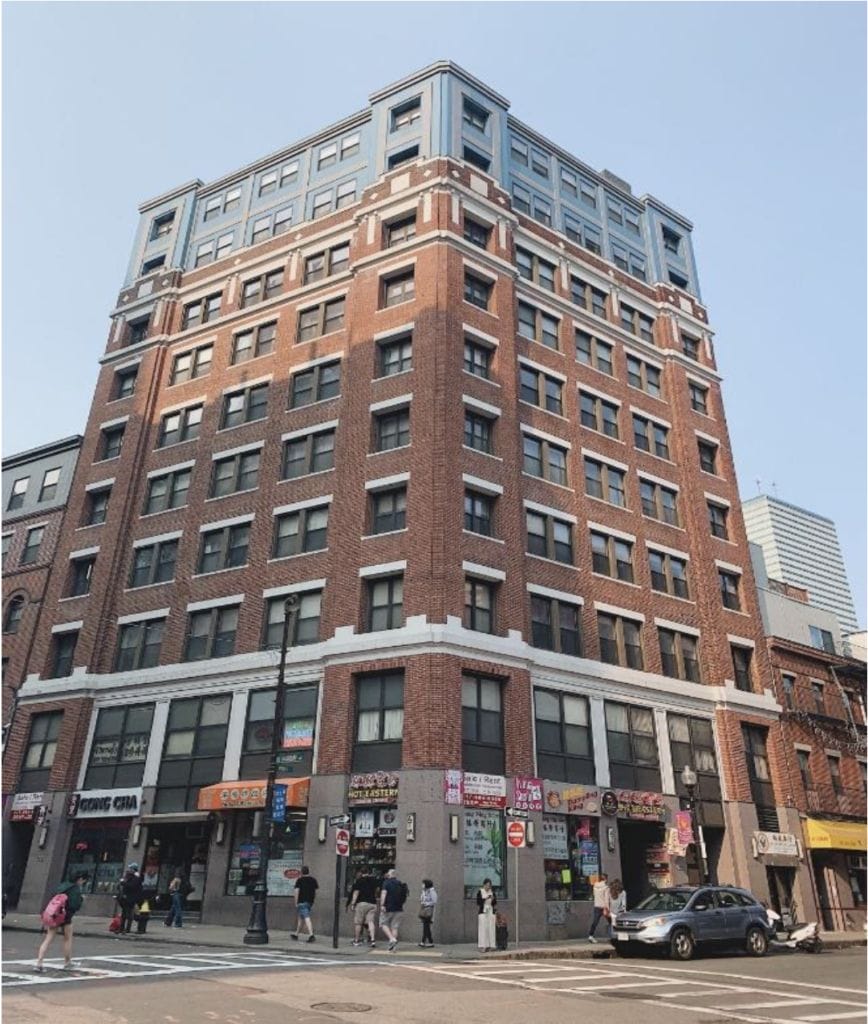
“Blue Top” by Meihua.
Countering stereotypes of Chinatown as “dirty” was important to Meihua. She wrote that it is important to acknowledge that “beauty is around you.” By playing with angles, her photos captured particular perspectives of key buildings, giving insight to what she wrote of “the sense of community to support Chinatown.” In “Blue Top” the top of a modern high-rise building forms a “V” toward the viewer, blending into the bright blue sky. In contrast, the bottom of the composition features an inverted “V” created by the crosswalks of the hustle and bustle at street level. Together, these contrasting angles draw the viewer’s attention to the central building that represents both the modern architectural developments and the Asian businesses below, which may be read as representing both sides of Chinatown.
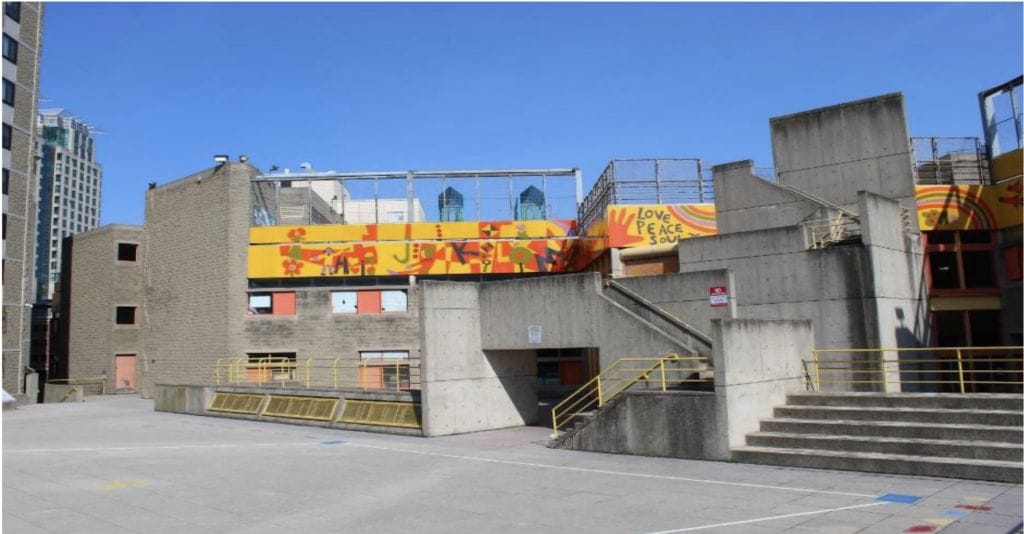
“Concrete Jungle” by Edward.
Similarly, Edward played with angles in “Concrete Jungle” with a photo of his former elementary school. In snapping a photo of the school, he crouched down to capture the angle of a young child, remembering how he had seen the school as a child.
“Go”: Capturing the dynamic nature of this ethnic enclave
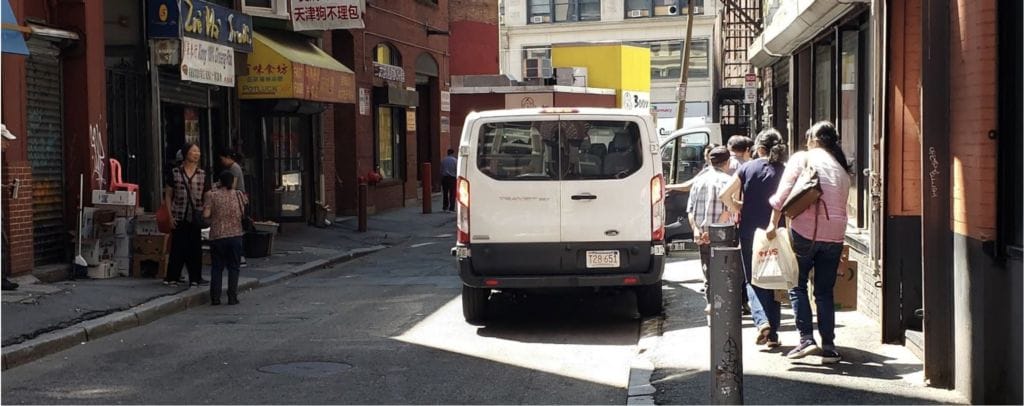
“Go” by Cathy.
Markusen and Gadwa (2010) write that place keeping is important because it enables residents and other community stakeholders to shape and control narratives about themselves, to remember and write their own history, and, in doing so, foster inclusive belonging. As such, there is growing evidence that place keeping can decrease stress, increase usability, incur social benefits, increase social interaction, and contribute to a sense of community (Dempsey and Burton 2012). Fang Fang wanted people to know that Chinatown is more than restaurants. Although not a resident herself, she considers it her “second home” since she works here and comes into the neighborhood five days a week. She presented “a day in the life” of her day-to-day experience of working in Chinatown. With her photos, she wanted viewers to see the “excitement in everyday things” and not just think of the food in Chinatown. Her photos captured her daily life, her walk to South Station, the boba drinks that she gets as a snack during work.
In a similar vein, some residents and workers captured rituals unique to Chinatown. These are everyday practices that the outsider eye may miss. Eugene photographed the long line of people waiting to get a freshly slaughtered chicken. The picture of the van that comes to Chinatown to pick up workers for the suburbs is captured in “Go” by Cathy, taken with a wide angle, capturing the entirety of the Chinatown street. The white van is the focal point, following “the rule of thirds” as a mechanism that successfully draws the viewer’s eye right to the van.
Unsung Heroes: Amplifying a resident- and worker-centered, Chinese American narrative in the face of gentrification
Inside Chinatown asked residents and workers to consider questions of what it means to be Chinese in America and how that identity is articulated in and through the physical space of Chinatown. Today, again, Chinatowns are seen as dangerous. These photographs are even more poignant and relevant today given the fears about Chinese immigrants and Chinatown during the COVID-19 pandemic. Historically, Chinatowns were viewed as a dangerous place, a den of vice that justified segregation and containment (Lee 1999, Tchen 1999, Lee 2001, Park 2010, Wong 1995). Deep-seated racism has reared its ugly head once more, with Chinese individuals attacked in public and some Chinatowns losing close to 70 percent of business during the pandemic (Lee 2020.) Top government officials fan the flames of xenophobia by calling COVID-19 “the Chinese virus.” Because of this racism, it is even more critical to implement projects like Inside Chinatown for workers and residents to have a voice in defining Chinatown for themselves and their families.
Inside Chinatown sought to create counternarratives of Chinatown from participants’ perspective, addressing stereotypes of the neighborhood and creating counternarratives in the wake of gentrification. Through visual storytelling, observation, and the creation of the photo captions residents and workers captured the sense of Chinatown as a place with cultural practices and longstanding rituals where people have survived and thrived despite discrimination and structural racism. The photographs of Inside Chinatown captured the humanity and reality of what it means to live and work in Chinatown, enabling the residents and workers to reclaim this neighborhood on their own terms and from their own perspectives and standpoints. Creating primary source material was the vehicle to help participants develop photography skills. Giving participants autonomy of their subject matter created the space for each to exhibit personal creativity by telling the story of Chinatown from their unique perspective and what they want future generations to remember.
Inside Chinatown gave residents and workers the tools to capture the beauty and complexity of their everyday life in Chinatown. Participants sought to get beneath surface-level understandings of Chinatown and the people who make up this vibrant, dynamic, and exciting neighborhood. In doing so, they provided important insights on a community that outsiders often neglect to see or notice. Their photographs elevated the people in the neighborhood whose stories are often silenced or invisible, yet keep the community vibrant and dynamic.
The intergenerational classroom space of Inside Chinatown enabled participants to co-construct a new Chinese American identity on their own terms. The photos force the viewer to confront the image of Chinatown as a place and disrupt the notion of Chinatown as exotic. Housing the photographs and artists’ statements at CHSNE was an explicit pedagogical tool so that the photographs are accessible to future students of all ages and the community, particularly those who may not have access to formal institutions of learning.
With their cameras in hand, participants were not only protagonists but also directors in creating these counternarratives of Chinatown, providing unique perspectives on the changing and evolving Chinatown. In this dynamic classroom space, no one person was seen as the expert; no one voice was privileged because of background, credential, or level of education. Meaningful, in-depth intergenerational dialogue was as important as teaching Asian American history and the technical skills of photography. In highlighting the value of everyday life in Chinatown, the residents and workers found a place to connect that enabled them to create and recreate an emotional home, finding a place in this era of displacement.
This desire for home was especially salient for the elders in the program, many of whom had moved away from Chinatown to live with their children because the family was priced out of the neighborhood. In the suburbs, elders can experience isolation, loneliness, and boredom. Many were happy to come back to their Chinatown home and find a new sense of camaraderie and kinship with complete strangers of different generations. The relationships forged during the project were powerful, catalyzing dynamic intergenerational relationships and connections, demonstrating how creative work can help to build powerful relationships.
During this critical moment in Chinatown’s history, when its borders and people are threatened, the photographs and stories of the residents and workers became part of a larger, community narrative of resilience. With the keen eye of an “insider,” the residents and workers of Inside Chinatown created an intergenerational collective narrative that focused on the beauty and meaning of everyday life in this historic ethnic enclave.
Find the Classroom Connections that accompany our article here.
Acknowledgements
This paper honors the work, legacy, and life of Tunney Lee, Chinatown historian, activist, and teacher. We thank the funders: the Boston Cultural Council, Mass Humanities (which receives support from the Mass Cultural Council and is an affiliate of the National Endowment for the Humanities), ArtPlace America, and the Barr Foundation. We thank those who made this project possible: the teachers, Tunney Lee, Katie Salisbury, Denise Khor, and Jessica Wong Camhi; organizational collaborators: the Chinese Historical Society of New England, University of Massachusetts Labor Resource Center, and Chinese Progressive Association; and project staff: Vanessa Woo, Project Associate, and Claire Freeman, Project Intern. We thank Amanda Yuan for her work as a research assistant in preparing the bibliography.
Carolyn Leung Rubin, EdD, is Assistant Professor at Tufts University School of Medicine. She was the lead evaluator for Pao Arts Center.
Loan Thi Dao, PhD, is Associate Professor and Director of Ethnic Studies at St. Mary’s College of California.
Izabela Villanueva, MS, is an alumna of the Transnational Cultural and Community Studies Program at University of Massachusetts Boston.
Cynthia Woo, MA, is Director of Pao Arts Center, Boston Chinatown Neighborhood Center.
Works Cited
Anderson, Kay J. 1987. The Idea of Chinatown: The Power of Place and Institutional Practice in the Making of a Racial Category. Annals of the Association of American Geographers. 77.4:580-98. doi.org/10.1111/j.1467-8306.1987.tb00182.x
Andreoli, Elisabetta. 1994. Lina Bo Bardi: The Anthropological Gaze. Third Text. 8.28-29:87-100. doi.org/10.1080/09528829408576504
Asian Americans Advancing Justice. 2011. A Community of Contrasts: Asian Americans in the United States. Accessed August 14, 2020 https://www.advancingjustice-aajc.org/sites/default/files/2016-09/Community_of_Contrasts_US.pdf.
Dempsey, Nicola, and Mel Burton. 2012. Defining place-keeping: The long-term management of public spaces. Urban Forestry & Urban Greening. 11:11–20.
Fairbairn, Gavin J. 2005. Storytelling, Ethics and Empathy. International Journal of Communication Ethics. 2.3:48-55.
Greene, Stuart, Kevin J. Burke, and Marcia K. McKenna. 2018. A Review of Research Connecting Digital Storytelling, Photovoice, and Civic Engagement. Review of Educational Research. 88.6:844–78. doi.org/10.3102/0034654318794134
Hirabayashi, Layne Rho. 1995. Back to the Future: Re-framing Community-Based Research. Amerasia Journal. 21.1-2:103-18. doi: 10.17953/amer.21.1-2.1714484534447351
Le, Emily and Sheila Sy. 2019. Incorporating Community Engagement into Asian American Studies Curriculum Reform. AAPI Nexus: Policy, Practice and Community. 16.1-2:137-52. doi.org/10.36650/nexus16.1-2_137-152_LeSy
Lee, Anthony. 2001. Picturing Chinatown: Art and Orientalism in San Francisco. Berkeley: University of California Press.
Lee, Fiona. 2020. COVID-19 Is Bringing Out Deep-Rooted Racism in the Bay Area. The Bold Italic. Accessed March 31, 2020, https://thebolditalic.com/covid-19-is-bringing-out-deep-rooted-racism-in-the-bay-area-6829dce987f8.
Lee, Heather R. 2013. A Life Cooking for Others: The Work and Migration Experiences of a Chinese Restaurant Worker in New York City, 1920-1946. In Eating Asian America, eds. Robert Ji-Song Ku, Martin Manalansan, and Anita Mannur. New York: New York University Press.
Lee, Robert G. 1999. Orientals: Asian Americans in Popular Culture. Philadelphia: Temple University Press.
Main, Kelly Leilani and Diana Bell. 2019. Forced from Home: A Human Rights Assessment of Displacement and Evictions in Boston’s Chinatown. Report published by the MIT Department of Urban Planning, Displacement Research and Action Network. Accessed March 31, 2020,
https://dusp.mit.edu/news/boston%E2%80%99s-chinatown-forced-home.
Markusen, Ann and Anne Gadwa. October 2010. “Creative Placemaking.” Mayors’ Institute on City Design and the National Endowment for the Arts, http://www.nea.gov/pub/CreativePlacemakingPaper.pdf
Omatsu, Glenn. 1994. The “Four Prisons” and the Movements of Liberation: Asian American Activism from the 1960s to the 1990s. In The State of Asian America: Activism and Resistance in the 1990s, ed. Karin Aguilar-San Juan. Boston: South End Press, 19-69.
Osajima, Keith. 1998. Pedagogical Considerations in Asian American Studies. Journal of Asian American Studies. 1.3:269-92. Doi.org/10.1353/jaas.1998.0028
Park, Jane Chi Hyun. 2010. Yellow Future: Oriental Style in Hollywood Cinema. Minneapolis: University of Minnesota Press.
Prasetyo, Yanu. 2017. From Storytelling to Social Change: The Power of Story in the Community Building. Social Science Research Network Electronic Journal. doi.org/10.2139/ssrn.3094947
Spiegel, Samuel J. 2020. Visual Storytelling and Socioenvironmental Change: Images, Photographic Encounters, and Knowledge Construction in Resource Frontiers, Annals of the American Association of Geographers. 110.1:120-44. doi.org/10.1080/24694452.2019.1613953
Tchen, John Kuo Wei. 1999. New York before Chinatown: Orientalism and the Shaping of American Culture. Baltimore: Johns Hopkins University Press, 1776-1882.
Wang, Caroline, and Mary Ann Burris. 1997. Photovoice: Concept, Methodology, and Use for Participatory Needs Assessment. Health Education & Behavior. 24.3:369–87. doi.org/10.1177/109019819702400309
Wong, K. Scott. 1995. Chinatown: Conflicting Images, Contested Terrain. MELUS. 20.1:3. doi.org/10.2307/467850
